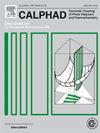基于 CALPHAD 方法的 Co-V-Zr 体系 γ + γ′ 显微结构表征研究
IF 1.9
3区 材料科学
Q4 CHEMISTRY, PHYSICAL
Calphad-computer Coupling of Phase Diagrams and Thermochemistry
Pub Date : 2024-10-28
DOI:10.1016/j.calphad.2024.102762
引用次数: 0
摘要
新型 Co 基超合金中的γ + γ′ 显微结构通常是通过合金化方法获得的。因此,本研究重点利用CALculation of PHAse Diagram(CALPHAD)方法探讨了添加Zr后γ+γ′微观结构的演变。τ的热容量通过蓝宝石法进行实验测定,τ在0 K时的形成焓则通过密度泛函理论(DFT)进行计算。热力学参数是根据相平衡数据的实验结果和使用 CALPHAD 方法进行的第一原理计算得出的。热力学分析表明,Co80.0V18.5Zr1.5(at. %)合金在 1473 K 下均质 10 h,在 1173 K 下老化不同时间后,有序的 L12-γ′ 沉淀在 2 h 后粗化并溶解,老化 67 h 后转变为针状的 D019-Co3V,这表明γ′相在 Co-V-Zr 体系中并不处于热力学稳定状态。如果要获得稳定的γ′相,就必须添加额外的合金元素。本文章由计算机程序翻译,如有差异,请以英文原文为准。
Study on the γ + γ′ microstructure characterization of the Co–V–Zr system based on CALPHAD method
The γ + γ′ microstructure in novel Co-based superalloys is often obtained by means of alloying method. Therefore, this study focuses on exploring the evolution of the γ + γ′ microstructure through the addition of Zr using CALculation of PHAse Diagram (CALPHAD) method. The heat capacity of τ was experimentally determined by the sapphire method, and the enthalpy of formation of τ at 0 K was calculated using Density Functional Theory (DFT). The thermodynamic parameters were derived based on experimental results from phase equilibrium data and first-principles calculations using CALPHAD method. According to the thermodynamic analyses, the alloy Co80.0V18.5Zr1.5 (at. %) was homogenized at 1473 K for 10 h and aged at 1173 K for different time, the ordered L12-γ′ precipitates coarsened and dissolved after 2 h, and transformed into needle-like D019-Co3V after 67 h of aging, which indicated that the γ′ phase was not in a thermodynamically stable state in the Co–V–Zr system. If the stable γ′ phase is obtained, additional alloying elements is necessary to be added.
求助全文
通过发布文献求助,成功后即可免费获取论文全文。
去求助
来源期刊
CiteScore
4.00
自引率
16.70%
发文量
94
审稿时长
2.5 months
期刊介绍:
The design of industrial processes requires reliable thermodynamic data. CALPHAD (Computer Coupling of Phase Diagrams and Thermochemistry) aims to promote computational thermodynamics through development of models to represent thermodynamic properties for various phases which permit prediction of properties of multicomponent systems from those of binary and ternary subsystems, critical assessment of data and their incorporation into self-consistent databases, development of software to optimize and derive thermodynamic parameters and the development and use of databanks for calculations to improve understanding of various industrial and technological processes. This work is disseminated through the CALPHAD journal and its annual conference.

 求助内容:
求助内容: 应助结果提醒方式:
应助结果提醒方式:


